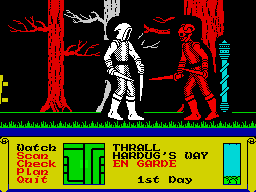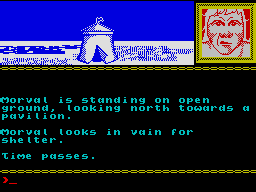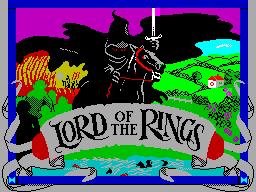
Last month Pete Tamblyn, freelance game designer and regular contributor to WHITE DWARF, explained what role-playing is in terms of more familiar gaming styles such as adventure gamebooks and computer adventures. Now he looks at how role-playing games have been converted to run on computers, with particular reference to the Spectrum, of course...
Despite the seemingly logical progression from gamebooks through computer adventures to role-playing that I outlined last issue, role-playing actually came first. The other two forms are the result of attempts to adapt role-playing to different media. The original Adventure and other pioneering computer games were written for mainframes and circulated largely through professional programming circles. But way back in 1981 those of us old enough (and, pre-Spectrum, rich enough) to be using micros for games were dazzled by the appearance of the original on which Swords & Sorcery is based.
The game is called Wizardry. NOT the same game as the similarly named product you can now get for the Commodore. In fact it is only available on business micros, but it is still selling well, having successfully made the transition from Apple Ito IBM PC to Macintosh. In a world where most computer games only last a few months, a five-year lifespan must in itself be something of a record.
In appearance Wizardry is very similar to S&S. It has the same perspective view down the tunnels, the same static view of creatures you meet, in fact almost an identical screen layout. It doesn’t have the top-down view of the map, but being disc-based it can afford to have completely separate screens for things like messing around with what you are carrying and wearing. In addition it allows you a party of up to six characters, and you can take them out of the dungeon to buy new equipment, get healed and gain experience. You can even rescue the bodies of dead characters and pay the local temple to have them resurrected. Since Wizardry first appeared a number of other games building on the idea have been produced, but they have all been American, disc-based and have made very little impact over here.

I’ve been waiting a long time for something like Wizardry to appear on the Spectrum, and I suspect that the fact that Wizardry is so good is in part responsible for my extreme disappointment in Swords & Sorcery. In fact it is a reasonable copy, improving on the original in some places, but there are are a number of very irritating things about it: the sound effects, the garish screen (which is almost unreadable on my small TV), the awful strip menu system, and the ridiculous number of orders you have to issue in order to take the treasure from a chest all combine to put me off the game. If a human GamesMaster didn’t allow you to eat your sandwiches until you’d specifically told him that you were taking them out of your pack first, you would probably hit him! S&S insists on such ridiculous detail. More importantly, S&S doesn’t allow you to come out of the dungeon and seems to have a very high kill rate. I found it very difficult to role-play, whereas in Wizardry I become so fond of good characters that I waste a fortune trying to get them resurrected when I do make a mistake.
One very brave thing that PSS did with S&S is to try to implement a means of communicating with the non-player creatures. Unfortunately this doesn’t work very well. To start with, much of the conversation that the computer generates is infantile: the authors seem to have thought that the game would only ever be played by five-year-olds. Also, because the system isn’t clever enough to indulge in meaningful conversation, you find yourself thinking “what does it mean in game terms when a character says that”.
My judgement of S&S, then, is that it is an attempt to put role-playing on a computer, but that it fails because there are so many facets of the game which irritate, are destructive of atmosphere, and forcibly remind you that you are only playing a game. I much prefer Heavy on the Magick. That looks better, has a much better user-interface, and is entertaining thanks to the traditional GARGOYLE humour. Of course it is still very much a traditional GARGOYLE logic puzzle once you get into it, and it still doesn’t allow you to come out of the dungeon to rest and recuperate. It’s much more fun to play!
I spoke to Greg Follis of GARGOYLE and the world of Graumerphy to see what he thought of role-playing on computers. It seems that HotM was indeed designed to implement as many features of Dungeons & Dragons (the first role-playing game) as possible, but this was carefully balanced against the requirement for good graphics and a playable game. As they had to leave something out, they tried as much as possible to get the atmosphere of D&D rather than reproduce the mechanics of the game. That certainly seems to be the right approach. Another interesting fact is that, before HotM was written, GARGOYLE went through the exercise of creating a complete world in which to set the game. Although in HotM itself Axil never gets out of the dungeon there is, in fact, a whole world there waiting for him. GARGOYLE hope to publish a book about Graumerphy sometime in the future.
That presents a number of intriguing possibilities. To start with, information from the book could be used as clues in later releases using the HotM system. This would give a lot more identification with the game world. One of the major problems with adventures is that you often can’t convey enough information in the game to be able to base the entire game on internal material: you have to bring in puzzles that are not an integral part of the plot. With a whole book to draw on things get much easier. (MELBOURNE HOUSE did something of the sort with Lord of the Rings as did games such as the Midnight series and Runestone which provided lots of background material in the instruction booklet). Also, with all that background, GARGOYLE could produce a role-playing game set in Graumerphy and allow you to carry characters across from the multi-player role-playing scenarios to the solo scenarios on the computer. Whether they will actually do such a thing is another matter, but the possibility is there.

A more recent contender in the field is the French game, Mandragore. This is a far more ambitious program, being much larger than S&S or HotM (on the Spectrum it comes as two tapes). Like S&S it tries hard to implement the mechanics of Dungeons & Dragons. Up to four characters are allowed, and they are able to adventure through a ‘wilderness’ (that’s an old D&D term for ‘outdoors’) as well as explore a number of dungeons (sorry, ‘chateaux’). Having several named characters does improve the atmosphere somewhat although, unlike Wizardry, each party is separate; you can’t have a pool of characters and pick the four you want. The game also includes villages at which you can buy (or steal) equipment. Nevertheless I was still disappointed by relatively trivial irritations.
The main problem is that the game’s designer, having got this nice fantasy world set up, can’t think of anything to do with it other than set silly brain teasers. At least in a LEVEL 9 game the problems, if not an obvious part of the plot, don’t seem too out of place. In Mandragore each Chateau has its own abstract puzzle. I’m sure the problems are very ingenious, but why should people playing the parts of a barbarian warrior and beautiful priestess want to spend their time solving mathematical conundrums?
What we have seen so far, then, is that computer games can make a reasonable stab at reproducing the atmosphere of role-playing, but as yet have fallen rather short. The main problems are lack of memory, the inability of the computer to hold a conversation with the player, and designers who try to write ‘role-playing’ games without seeming to have much understanding of what role-playing is all about.
With the advent of more powerful machines and disc drives (256K Spectrum?) we can hope for considerable improvements: bigger games, more text and pictures, and multi-player facilities. In the meantime, game designers should bear in mind that, if they want to produce role-playing games, they should go for atmosphere — good stories and/or good graphics — rather than worry about complicated mechanics.
I haven’t said anything so far about computer-moderated play-by-mail games or BRITISH TELECOM’s Multi-User Dungeon. Obviously such games, being run on far more powerful computers, come much closer to the ideal. However, they can prove extremely expensive, and you are obliged to play with anyone else that the game company happens to admit to the game. Personally such things don’t appeal, but you’ll be able to make up your own minds by following Brendon Kavanagh’s new column.
What I will mention, however, is Mike Singleton’s new game, Dark Sceptre. When I spoke to Mike he was quite adamant that role-playing didn’t interest him and that what he tried to write was strategy games in a fantasy setting. Nevertheless (and bearing in mind that the game wasn’t finished when I wrote this so I haven’t actually seen it working) Dark Sceptre does seem to have a lot of promise.

Firstly Mike has tackled the interaction problem by offering a play-by-mail (and Microdrive) version of the game. Whereas the solo game has one team of characters controlled by you and seven controlled by the computer, in the PBM version each team will be a separate player. There is also a nice feature from the story-telling point of view: when you get your Microdrive cartridge back at the end of a turn you can set the game up and see that turn’s events played out on the screen. You’ll even be able to get the computer to make a guess at how the story continues, based on what it knows of your intentions and those of other players’ intentions. Finally, Mike assures me that each character in the game has personality traits (aggressiveness, greed, and so on) which can affect the game play and can be changed by events in the game. Considering that Mike didn’t set out to produce a computerised rolegame, it is ironic that he may well have come closest yet to succeeding.
Finally, what about this question as to whether role-playing games are Adventures or Strategy Games, and therefore whether they belong in Derek’s column or Sean’s? Personally I think the argument is silly. Games which require brain instead of a steady joystick hand get poor enough treatment from magazines as it is without making matters worse by fighting amongst themselves, but there is a division, and it is one that exists within role-playing itself.
The people who invented role-playing, Gary Gygax and Dave Arneson, are keen wargamers. So are many of the people who now run role-playing companies: Bryan Ansell of GAMES WORKSHOP, for example. And, of course, there are many wargamers who also role-play. Some of these people prefer to ignore the actual role-playing element entirely and treat the whole thing as a wargame with an incredibly complex set of rules. At the opposite extreme some role-players advocate doing away with rules altogether, relying instead on the GamesMaster’s judgement. Most people fall somewhere in the middle, and depending on which side of the mid point they fall they will tend to see role-playing as closer to either Adventures or Strategy Games.
There is no simple categorisation...